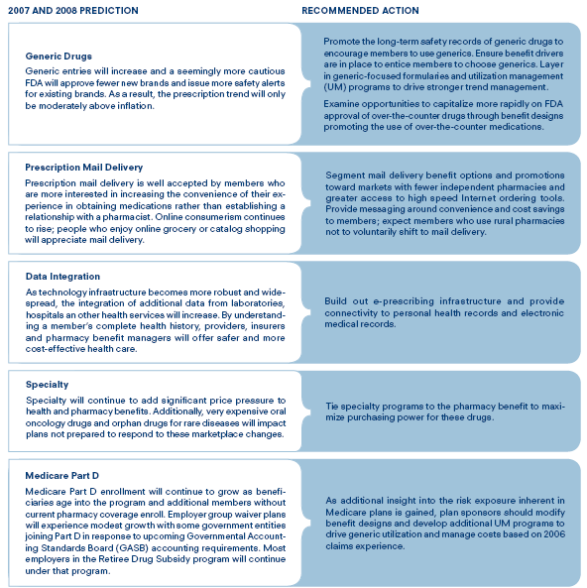As you may know, Prime Therapeutics is a PBM headquartered in Minneapolis that is owned by a group of BCBS plans. I just had a chance to read their Drug Report this past week. As I have talked about Caremark, Express Scripts, and Medco, I thought I would share a few comments and highlights here.
First, I thought it was interesting in that it took a slightly broader perspective (perhaps the BCBS influence) on the industry dynamics. It mentioned the war and YouTube (for example). [I don’t think I have seen many other people in healthcare even acknowledging YouTube.]
I was surprised by a 2004 Rand and BCBSA study they quoted saying that “approximately 70 percent of survey respondents cited the Internet as their main source of health information” thereby supplanting the role of the personal physician as the primary source.
Given the focus on wellness across the industry, I found their list of common components and incentives that are used in creating a wellness program to be a good, quick checklist.

I couldn’t figure out two things that were either “corporate DNA” opportunities or something different about their pricing and plan designs.
- They say that plans that transition to Prime from other PBMs save 4.5 percent. (Which is significant.)
- They also said that their utilization was only 10.65 in 2006 which would be lower than most numbers that I have seen.
They do a good job of explaining some of the generic scenarios in the industry as people try to get that small advantage.
At-Risk Launches
Several generic companies launched their products ‘at-risk’, which means that the FDA has granted approval to their product prior to the expiration of a patent that is contested in court, but after all applicable exclusivity periods have ended. These ‘at risk’ generics, including generics of Biaxin®, Plavix®, Toprol XL® and Wellbutrin XL®, are subject to large penalties payable to the brand-name drug manufacturer if they lose pending lawsuits. Citizen Petitions Brand drug manufacturers, or their agents, frequently use Citizen Petitions in attempt to slow down the approval of generics. These are not legal proceedings in the typical sense, as they usually do not involve specific protection of a patent. The FDA must make a ruling on a Citizen Petition before it approves a generic, and this frequently takes a significant amount of time. These products are currently involved in Citizen Petitions: Lovenox®, Concerta®, Catapres TTS®, Skelaxin®, Vancocin®, Miacalcin® and Flovent®.
Authorized Generics
With authorized generics, the brand-name drug manufacturer makes its own generic version of its own brand-name drug. By doing this, they can reduce the profit a first-to-file generic company reaps during generic exclusivity periods, which could discourage generic companies from entering the market.
Agreements Between Brand and Generic Companies
Another pressing issue, which has also been around for several years, involves agreements between brand and generic companies. These agreements end litigation and keep generics off the market for a period of time, but still may allow generics on the market before all patents have expired. Sometimes these agreements involve payments to generic drug manufacturers in an effort to delay the release of the generic product.
The other thing that I thought was a good summary in their document was their predictions for 2007 and 2008.
If you like this post and are interested in the topics here, don’t forget to sign up for my e-mail updates or add the RSS feed from the blog to your reader.

 February 22, 2008
February 22, 2008 



Is this trend report public? Is there a 2008 document (summarizing 07 and predicting 09) available?
I believe you have to request it from them. It is not available for download off of their website. The 2008 document is not published yet, but you can register to receive it here.
As to your comment that no one in health care is acknowledging YouTube, here are some links to videos on YouTube posted by some well-known hospitals, like Vanderbilt. Based on the sign-up date, this appears to be a new tactic to try to spread airplay.
I. St. Thomas Hospital
http://www.youtube.com/watch?v=1nWfeVqkWPQ
http://www.youtube.com/watch?v=kGSYNpdJk5c&NR=1
II. Vanderbilt Medical Center
http://www.youtube.com/watch?v=JwnPxOTTSo8
http://www.youtube.com/watch?v=25C8Gi9s-1g